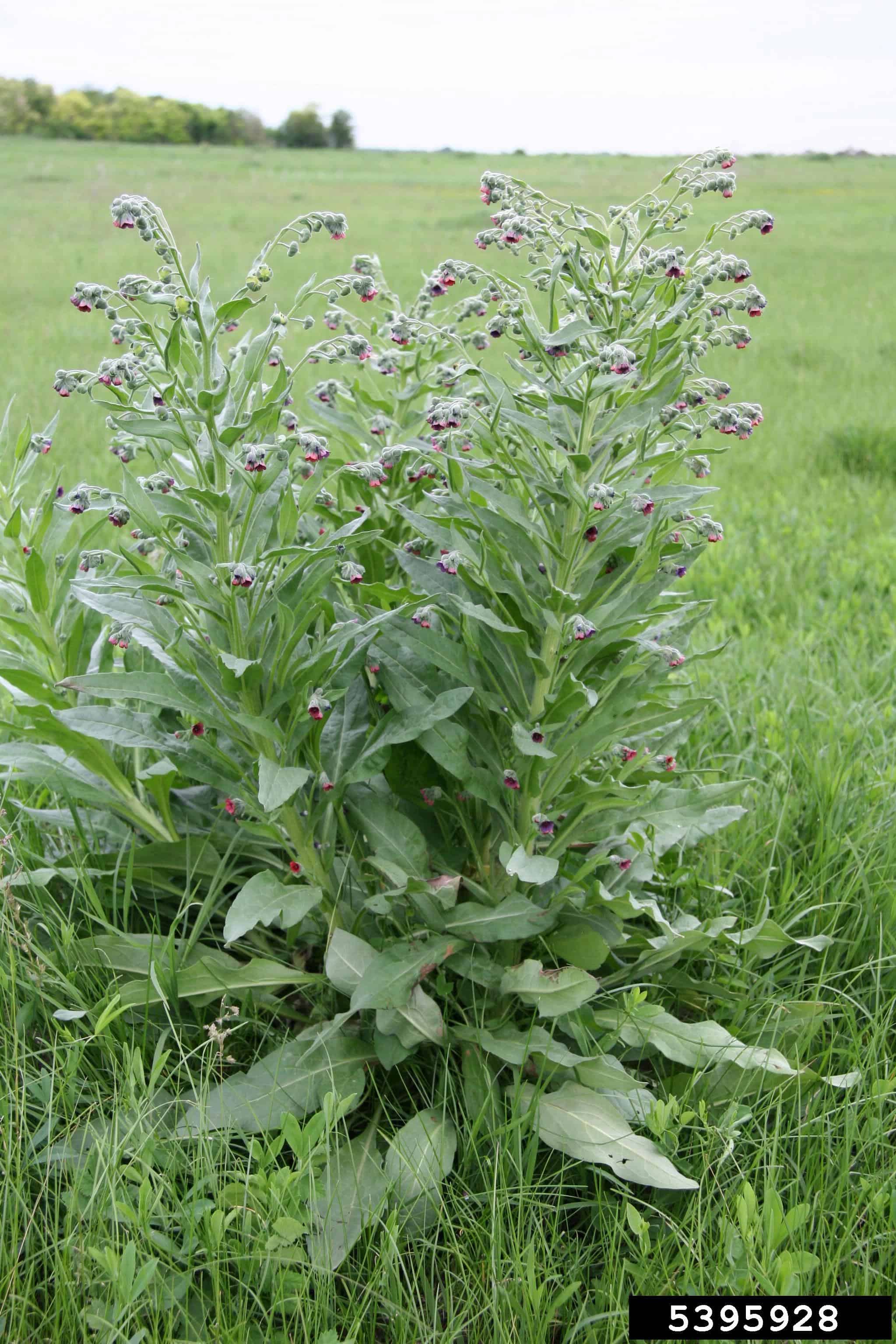Cynoglossum officinale
Explore More :
Explore plus :
Overview
Aperçu
Regulation :
Remarques Réglementation:
- Quarantine lists of countries e.g. India *may be updated without notice
Regulation Notes:
On quarantine lists of countries e.g. India*.
*Quarantine lists of countries may be updated without notice.
Distribution :
Répartition :
This species is native to Europe and parts of western Asia (Upadhyaya 1988; USDA-ARS 2017). It was introduced to parts of northern Europe and North America, cultivated in Europe and China (USDA-ARS 2017). In the United States, it is present in every state except Florida, Louisiana, Mississippi, Oklahoma and Texas (USDA-NRCS 2017).
Habitat and Crop Association :
Habitat et Cultures Associées :
This species occurs in pastures, rangeland, old fields, abandoned cropland, roadsides and disturbed areas (Upadhyaya et al. 1998; Darbyshire 2003).
Economic Use, cultivation area, and Weed Association :
Utilisation économique, zone de culture et association de mauvaises herbes :
Duration of Life Cycle :
Durée du cycle vital:
Biennial or short-lived perennial
Dispersal Unit Type :
Type d’unité de dispersion :
Nutlet
General Information
RENSEIGNEMENTS GÉNÉRAUX
Hound’s tongue reproduces by seed, which attach readily to animal hair/fur/wool. Generally it is not a weed of cultivation but is poisonous to livestock and considered a problematic rangeland weed (Upadhyaya et al. 1988; Darbyshire 2003).
.
Cynoglossum officinale plants (Robert Vidéki, Doronicum Kft., Bugwood.org)
Identification
Identification
-
Nutlet
Size
- Nutlet length: 5.3 – 7.1 mm (average: 6.1 mm); width: 4.2 – 5.6 mm (average: 4.9 mm)
Shape
- Nutlet is teardrop-shaped and highly compressed
Surface Texture
- Nutlet is covered with spiny tubercles with hooked tips; tubercles denser around the edge of the nutlet
Colour
- Nutlet is dull or slightly shiny pale coloured to light brown; point of attachment is brown
Other Features
- The point of attachment is a smooth, teardrop-shaped, dull, flat patch on one side of the nutlet towards the narrow end

Hound’s tongue (Cynoglossum officinale) nutlets





Identification Tips
CONSEILS POUR L’IDENTIFICATION
Additional Botany Information
AUTRES RENSEIGNEMENTS BOTANIQUES

Cynoglossum officinale flowers (Joseph M. DiTomaso, University of California – Davis, Bugwood.org)





Similar Species
ESPÈCES SEMBLABLES
Similar species are based on a study of seed morphology of various species, and those with similar dispersal units are identified. The study is limited by physical specimen and literature availability at the time of examination, and possibly impacted by the subjectivity of the authors based on their knowledge and experience. Providing similar species information for seed identification is to make users aware of similarities that could possibly result in misidentification.
Andersonglossum virginianum (wild comfrey)
Andersonglossum virginianum nutlets are a similar size, teardrop shape, pale colour, dull point of attachment and spiny tuberculate surface as hound’s tongue nutlets.
Andersonglossum virginianum nutlets are less compressed than hound’s tongue nutlets and have a dull, roughened and wrinkled surface. The tubercles are dense over the entire nutlet. The point of attachment tends to be concave with a wide, striate-wrinkled rim.
Click to select species
Cliquez pour sélectionner les espèces

Andersonglossum virginianum
Comparison Window
Fenêtre de comparaison
MAIN SPECIES
ESPÈCES PRINCIPALES
Cynoglossum officinale

Cynoglossum officinale
Boraginaceae
Hound’s tongue (Cynoglossum officinale) nutlets
MAIN SPECIES
ESPÈCES PRINCIPALES
Cynoglossum officinale

Cynoglossum officinale
Boraginaceae
Hound’s tongue (Cynoglossum officinale) nutlets
MAIN SPECIES
ESPÈCES PRINCIPALES
Cynoglossum officinale

Cynoglossum officinale
Boraginaceae
Hound’s tongue (Cynoglossum officinale) nutlet
MAIN SPECIES
ESPÈCES PRINCIPALES
Cynoglossum officinale

Cynoglossum officinale
Boraginaceae
Hound’s tongue (Cynoglossum officinale) nutlet
MAIN SPECIES
ESPÈCES PRINCIPALES
Cynoglossum officinale

Cynoglossum officinale
Boraginaceae
Hound’s tongue (Cynoglossum officinale) nutlet; side view
SIMILAR SPECIES
ESPÈCES SEMBLABLES
Andersonglossum virginianum

Andersonglossum virginianum
Boraginaceae
Andersonglossum virginianum nutlets
SIMILAR SPECIES
ESPÈCES SEMBLABLES
Andersonglossum virginianum

Andersonglossum virginianum
Boraginaceae
Andersonglossum virginianum nutlet
SIMILAR SPECIES
ESPÈCES SEMBLABLES
Andersonglossum virginianum

Andersonglossum virginianum
Boraginaceae
Andersonglossum virginianum nutlet
Need ID Help?
Besoin d’aide pour l’identification?
Reference(s)
Référence(s)
Darbyshire, S. J. 2003. Inventory of Canadian Agricultural Weeds. Agriculture and Agri-Food Canada, Research Branch. Ottawa, ON.
Global Biodiversity Information Facility (GBIF) Secretariat. 2022. https://doi.org/10.15468/39omei Accessed via https://www.gbif.org/species/2925815 Accessed December 29, 2022.
Upadhyaya, M.K., Tilsner, H.R. and Pitt, M.D. 1988. The Biology of Canadian weeds. 87. Cynoglossum officinale L. Canadian Journal of Plant Science 68: 763-774.
U.S. Department of Agriculture-Agricultural Research Services (USDA-ARS). 2017. Germplasm Resources Information Network (GRIN), https://npgsweb.ars-grin.gov/gringlobal/taxon/taxonomysearch Accessed April 25, 2017.
U.S. Department of Agriculture-Natural Resources Conservation Service (USDA-NRCS). 2017. The PLANTS Database. National Plant Data Team, Greensboro, NC USA. https://plants.usda.gov/home Accessed April 25, 2017.
U.S. Department of Agriculture-Natural Resources Conservation Service (USDA-NRCS). 2022. The PLANTS Database. National Plant Data Team, Greensboro, NC USA. http://plants.usda.gov Accessed December 29, 2022.




